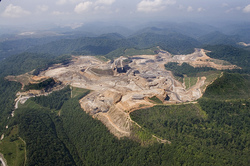EPA guidelines on mountaintop removal offer hope for Appalachia's environment
 The Environmental Protection Agency unveiled its promised guidelines for mountaintop removal coal mining last week, and they're getting praise from environmental advocates.
The Environmental Protection Agency unveiled its promised guidelines for mountaintop removal coal mining last week, and they're getting praise from environmental advocates.The new guidance would "severely limit the impacts on water caused by mountaintop removal in central Appalachia, an important step forward for protecting communities from the environmental and health impacts of mountaintop removal," according to a statement from the Alliance for Appalachia.
On Thursday, EPA announced a set of actions to strengthen permitting requirements for Appalachian mountaintop removal and other surface coal mining projects. The guidance sets out benchmarks for preventing damage to watersheds from what are known as "valley fills," which involve the dumping of mining waste into streams below.
"The people of Appalachia shouldn't have to choose between a clean, healthy environment in which to raise their families and the jobs they need to support them," said EPA Administrator Lisa Jackson. "We will continue to work with all stakeholders to find a way forward that follows the science and the law."
Noting that a growing body of scientific literature shows significant damages to streams from mountaintop removal mining, EPA has identified an acceptable range of electrical conductivity -- a measure of salt in the water -- to protect freshwater streams and their aquatic life.
The EPA intends to limit conductivity to between 300 and 500 microSiemens per centimeter -- about five times normal levels. Appalachian streams impacted by valley fills typically have conductivity upwards of 900 microSiemens per centimeter.
The guidance will take effect immediately on an interim basis while EPA solicits public comments. The agency is also awaiting the results of a technical review of its scientific reports.
While Jackson said no existing operations would be canceled, 79 major surface mining permits now under review would have to comply with the new standard.
"Either no or very few valley fills are going to meet standards like this," Jackson said at a press conference on the new guidance.
The National Mining Association, a group that represents mountaintop removal operators, said it was "deeply concerned" by the impact the policy would have on Appalachia's economy as well as the price of electricity.
U.S. Sen. Robert Byrd (D-W.Va.) met with Jackson several times to request a clear set of parameter for issuing mining permits in order to end uncertainty in the coal fields.
"I am pleased that EPA Administrator Jackson took our concerns about the need to provide clarity seriously and has responded with these guidelines," he said.
The guidance won praise from Sen. Lamar Alexander (R-Tenn.), whose coal-mining state already bans valley fills.
"Coal is an essential part of our energy future, but it is not necessary to destroy our mountaintops in order to have enough coal to meet our needs," he said.
Vivian Stockman with the Ohio Valley Environmental Coalition in Huntington, W.Va. said EPA's action shows it's finally listening to the voices of people impacted by mountaintop removal mining. However, she also observed that the effectiveness of the guidelines will depend on how well they're enforced.
Meanwhile, Appalachian Voices -- an environmental advocacy group based in North Carolina, the state that's the biggest consumer of mountaintop removal coal -- urged Congress to follow the administration's lead by passing the Clean Water Protection Act (H.R. 1310) and the Appalachia Restoration Act (S. 696), which is co-sponsored by Sen. Alexander.
"Change in Appalachia is now inevitable, and the time for Congress to pass this legislation is now," the group said in a statement.
(Photo of a mountaintop removal mining site near Rawl, W.Va. by Kent Kessinger, taken during an Appalachian Voices flight courtesy of SouthWings. Part of the National Memorial for the Mountains photo stream.)
Tags
Sue Sturgis
Sue is the former editorial director of Facing South and the Institute for Southern Studies.
